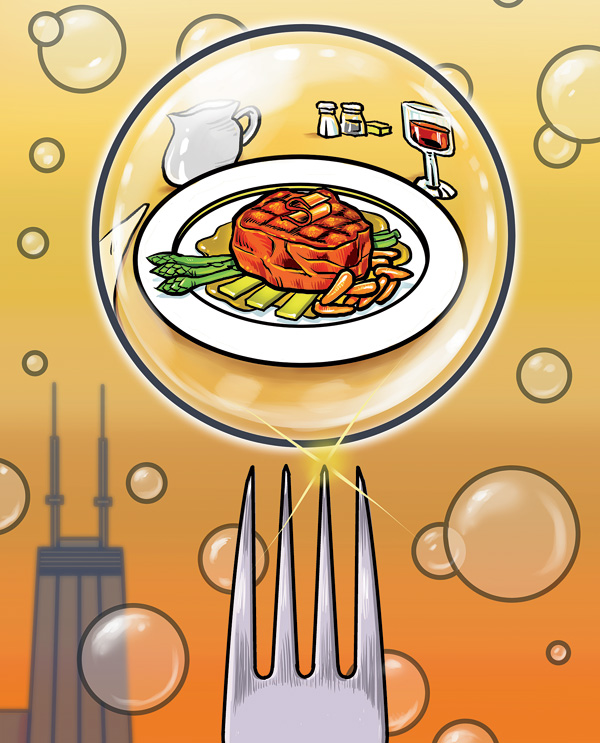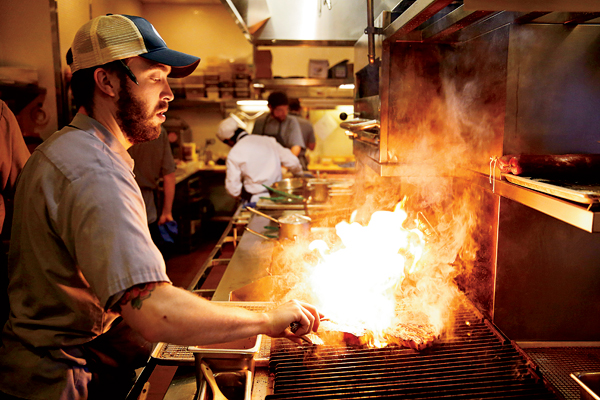
When Rob Katz and Kevin Boehm opened their flagship Lincoln Park restaurant Boka 14 years ago, more than 600 people lined up around the block looking for jobs. How times have changed. These days, when the duo launches a new place, “you put out an ad, you might get 10 people,” Katz says. “What was once a very fertile ground for talent is not any longer. People are fighting just to put a staff together.”
Such is life in the restaurant bubble. The boom of higher-end openings in Chicago over the past four years has depleted the available pool of waitstaff and kitchen help. What’s more, the fight for qualified workers has sent wages soaring, imperiling already thin margins. Add to that rising rents and property taxes, and the city’s restaurant industry is due for a reckoning.
“Is it a bubble?” asks Katz, whose Boka Restaurant Group operates more than a dozen local spots, including the ultrapopular Girl & the Goat and Swift & Sons. “I don’t know. But I do believe there will be some big names that maybe are going to get hurt.”
Of course, closings are common in this high-failure industry. What’s different now is the caliber of the restaurants that may not survive—ones putting out great food and packing the house. In the past year alone, such critical darlings as MK, Tru, Intro, 42 Grams, Dixie, Ruxbin, and Vera have bitten the dust. Expect others to follow.
It’s not as if the Girl & the Goats and Alineas of the world will shutter overnight, though; rather, the market will likely force the lesser-financed, lesser-experienced, and fringe players from the upscale dining scene. Big restaurant groups, on the other hand, can spread back-office costs across a broad revenue base, leaving the little guys to fight it out for the crumbs.
As the data shows, it’s a veritable cage match for survival. The number of leisure and hospitality establishments (the majority of which are restaurants) in the metro area is up 7 percent from just five years ago and a whopping 21 percent from 2007, reaching 24,500 at the end of 2017’s first quarter, the latest period for which figures are available. That’s even as the population has declined.
With workers more in demand, gone are the days when you could give a line cook $11 an hour and free dinner. Some now command $17 an hour plus health care—a tough bargain for restaurateurs with almost zero leeway in their budgets. But they have little choice but to pay. “At this point, if somebody walks through the door and they’re committed to working with us, we’ll pretty much hire them,” says Kimberly Galban, the director of operations for One Off Hospitality Group, which owns the Publican, Avec, and nine other spots in Chicago.
Restaurateurs are feeling pressed by more than labor. Rents in the Fulton Market area were only about $20 a square foot from 2010 to 2012, when the first of the new wave—Girl & the Goat, Maude’s Liquor Bar, Au Cheval—planted their flags there. Now they’re three to four times that. One restaurateur was recently asked to pay $110 a square foot in that neighborhood. He balked and moved his search a block north, just out of the hot zone.
Few restaurants can make those numbers work. “You can’t just start charging $26 for a cheeseburger and expect people are going to pay that,” says Lettuce Entertain You Enterprises president R.J. Melman. That’s especially true for upstarts. “You have to be pretty confident if you’re paying that kind of money,” says Reuben Rischall, the Chicago-based managing broker for Buyers Realty, which handles mostly hospitality and retail clients.
Rischall, for one, thinks an industry correction is inevitable: “Everybody sees it coming. In 2013, you just had to have good food and cocktails. Today, if you’re good but just run-of-the-mill, you’re going to get gobbled up in this market. You’ve got to almost knock it out of the park.”
Even then, you still might not make it. “You have to be so razor sharp on everything,” says Matthias Merges, a chef and the owner of Folkart Restaurant Management, which operates four Chicago restaurants, including Hyde Park’s acclaimed A10. “If you get everything to line up perfectly, then you might make it. Maybe.” He blames the summer 2017 closings of his Yusho restaurants in Logan Square and Hyde Park on “C to C-minus locations” that didn’t get enough foot traffic.
On the bright side, no one is suggesting a total collapse. Most higher-end restaurants are clustered in River North and the West Loop, which are in the midst of a condo-and-hotel-building rally that’s expected to bring thousands of people into the area. And lest we forget, the influx of corporate headquarters from the suburbs isn’t yet complete. McDonald’s, for example, is about to bring a thousand high-paying jobs to the West Loop, and man cannot survive on Big Macs alone.
All that amounts to more butts in seats, more built-in demand to balance out the inflated supply—for now. But booms bust. Bubbles burst. Which means creativity could suffer as restaurateurs grow reluctant to take chances. Call it the Epcotization of high-end dining—the restaurant version of “Just shut up and play the hits.”
The golden age of Chicago restaurants may be right now. Eat up while you still can.
Keeping Up with the Bokas
Here’s a look at what a few restaurant groups are doing to stay competitive.

Folkart Restaurant Management is using different cooking techniques, such as sous vide—and adding grill marks as a finishing touch—to prepare dishes more quickly. Such changes in process can reduce the number of cooks in the kitchen by half.
Lettuce Entertain You Enterprises is planning fewer new middle-tier spots, focusing instead on less labor-intensive fast-casual places, such as Wow Bao, and higher-grossing fine-dining restaurants like its RPM franchise.
One Off Hospitality Group, owner of Blackbird, Avec, and the Publican franchise, raised starting wages, instituted sick-leave pay, launched a retirement plan, and began offering health insurance—what once were nearly unheard-of benefits in the restaurant industry—in an attempt to retain top talent.
Avocado toast may be bankrupting millennials, but it’s keeping restaurants in business: 16” on Center, which runs Dusek’s, Longman & Eagle, and others, sees high-margin brunch as an essential offering.


